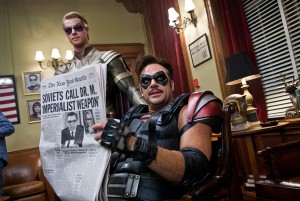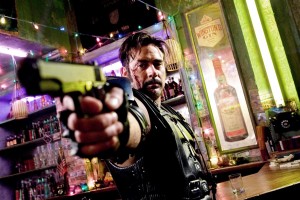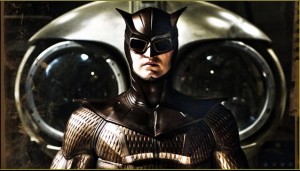Watchmen
 Among horror fans, there is a legendary moment in one of Wes Craven’s early films that would influence nearly every complex film that followed. Hurting for money, Craven went to the well to sequelize a film that would have a hard time being a sequel, seeing as pretty much every notable character died in the first film. Stuck in a jam, Craven created an ingeniously cheap way to solve that issue, structure the entire movie as a series of flashbacks, which would be a way to bring back the now-dead villains and more importantly, he could use footage from the first film. The result, The Hills Have Eyes Part II (not to be confused with the recent sequel to the remake of the original Hills), released in 1985, eventually runs out of people who can reminisce about their past, and decides to give a survivor who had no lines in the first film, the dog, his own lengthy flashback.
Among horror fans, there is a legendary moment in one of Wes Craven’s early films that would influence nearly every complex film that followed. Hurting for money, Craven went to the well to sequelize a film that would have a hard time being a sequel, seeing as pretty much every notable character died in the first film. Stuck in a jam, Craven created an ingeniously cheap way to solve that issue, structure the entire movie as a series of flashbacks, which would be a way to bring back the now-dead villains and more importantly, he could use footage from the first film. The result, The Hills Have Eyes Part II (not to be confused with the recent sequel to the remake of the original Hills), released in 1985, eventually runs out of people who can reminisce about their past, and decides to give a survivor who had no lines in the first film, the dog, his own lengthy flashback.
Zack Snyder’s adaptation of Alan Moore’s graphic novel Watchmen, is nearly 3 hours long, and has even more flashbacks than The Hills Have Eyes II. 85% of the movie is made up of characters reflecting upon how they got to that very spot, the spot where they decided to stop, look up to the sky, and think back.
 At the funeral of the conflicted, narcissistic, and mean-spirited superhero The Comedian (this is not a spoiler, they even show his murder in the TV ad), each of what appears to be ten different people get their own extremely detailed flashback to their interactions with their fallen friend. As the camera slowly moves past each character that had their screen time, eventually stopping at whom I thought was the priest, who then gets five minutes to look to his past, I kept waiting for the dirt and the coffin to get their fill in too.
At the funeral of the conflicted, narcissistic, and mean-spirited superhero The Comedian (this is not a spoiler, they even show his murder in the TV ad), each of what appears to be ten different people get their own extremely detailed flashback to their interactions with their fallen friend. As the camera slowly moves past each character that had their screen time, eventually stopping at whom I thought was the priest, who then gets five minutes to look to his past, I kept waiting for the dirt and the coffin to get their fill in too.
Watchmen’s intertwining circular plotting is faithful to the comic book (as are the selfish and morally questionable superheroes), but it is so scattered in the film version that there isn’t very much tension regarding the “now,” it appears that everything important for the viewer happened in the past. The only time this isn’t true is with the incredibly ballsy, nihilistic ending, but after our heroes get over the initial shock, they seem indifferent to it, so it doesn’t have as much impact as it should.
 However, that doesn’t mean everything is wrong with Watchmen, in fact there’s such a strange mix of the typical superhero nonsense (bright colors, punny jokes, characters who intentionally deepen their voice, war rooms out of Dr. Strangelove), with savage, brutal violence, that the juxtaposition can be overwhelming, and in a positive way. This surfeit of graphic carnage (which dwarfs the amount of cartoony Spiderman level deaths) helps us overlook Snyder’s tendency to overuse the same effect that wore me out during his last film, 300, in which, during a moment of action, the shot slows down, quickly speeds up, and slows down again upon impact. There’s also the issue of the attempts at historical recreations using real figures, but with look-alike actors wearing heavy makeup. Richard Nixon, who in this alternate universe, is still president in 1985, after term limits were abolished, has an extended nose worthy of Cyrano de Bergerac, and every time he appears, which is often, you can’t help but stare at it. One wouldn’t be out of line thinking, that any moment, a bird might land on his nose, and permanently use it as a perch.
However, that doesn’t mean everything is wrong with Watchmen, in fact there’s such a strange mix of the typical superhero nonsense (bright colors, punny jokes, characters who intentionally deepen their voice, war rooms out of Dr. Strangelove), with savage, brutal violence, that the juxtaposition can be overwhelming, and in a positive way. This surfeit of graphic carnage (which dwarfs the amount of cartoony Spiderman level deaths) helps us overlook Snyder’s tendency to overuse the same effect that wore me out during his last film, 300, in which, during a moment of action, the shot slows down, quickly speeds up, and slows down again upon impact. There’s also the issue of the attempts at historical recreations using real figures, but with look-alike actors wearing heavy makeup. Richard Nixon, who in this alternate universe, is still president in 1985, after term limits were abolished, has an extended nose worthy of Cyrano de Bergerac, and every time he appears, which is often, you can’t help but stare at it. One wouldn’t be out of line thinking, that any moment, a bird might land on his nose, and permanently use it as a perch.
The distraction of the Saturday Night Live level impressions starts in the first five minutes with an episode of The John McLaughlin Group and the majority of the first hour or so. It is hard to tell if Snyder intended it to be funny, but it just comes off as a Forrest Gumpy gimmick. But I don’t think Snyder was only interested in visual tricks, otherwise he wouldn’t have nabbed parts of Phillip Glass’ deadly serious Koyaanisqatasi score (is it a clever point Snyder is making that since Koyaanisqatsi is about the evils of industrialization, that it relates to Watchmen, which is about the downside of technological advances, and the de-evolution of the human-based superhero? Probably not) or bothered to develop any of the characters.
 The character development in Watchmen is a nice respite from the noise and fury, especially with regards to the giant, blue, and naked Dr. Manhattan, who, as he becomes more powerful, loses his connection with the human race and is having a hard time justifying protecting it. Dr. Manhattan’s progression of depersonalization is far more interesting than the oodles of screen time given to show how misanthropic The Comedian was and how he ties into the convoluted story. There’s just something about a basically ethereal figure brooding and making his personal Fortress of Solitude, on Mars, that’s fascinating. Especially as he reflects on how much attention he should paying to either saving the Earth or fingering his girlfriend.
The character development in Watchmen is a nice respite from the noise and fury, especially with regards to the giant, blue, and naked Dr. Manhattan, who, as he becomes more powerful, loses his connection with the human race and is having a hard time justifying protecting it. Dr. Manhattan’s progression of depersonalization is far more interesting than the oodles of screen time given to show how misanthropic The Comedian was and how he ties into the convoluted story. There’s just something about a basically ethereal figure brooding and making his personal Fortress of Solitude, on Mars, that’s fascinating. Especially as he reflects on how much attention he should paying to either saving the Earth or fingering his girlfriend.



